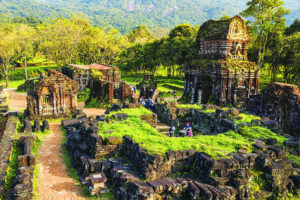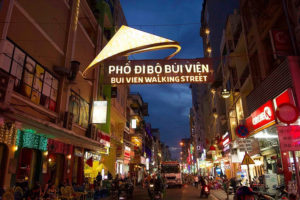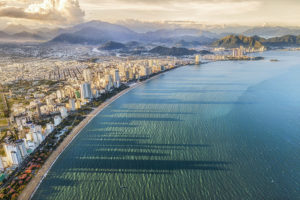24/7 Support: +84 903445750
Halong Bay: Information and Must-Do Activities
Ha Long Bay is a world-renowned destination, celebrated for its natural beauty with thousands of limestone islands and islets of various shapes and sizes scattered across the bay, creating a unique landscape unlike any other. International tourists visiting Vietnam often prioritize adding Ha Long Bay to their itineraries. In addition to admiring this natural wonder, there are many other exciting activities to explore. Let’s dive into the details below.
Overview of Halong Bay
Halong Bay is located in the eastern region of Northern Vietnam, approximately 170 kilometers from the capital, Hanoi, which is about a 2.5-hour drive by car. The bay covers a total area of 1,553 square kilometers and includes two renowned bays: Bai Tu Long Bay to the east and Lan Ha Bay to the south.
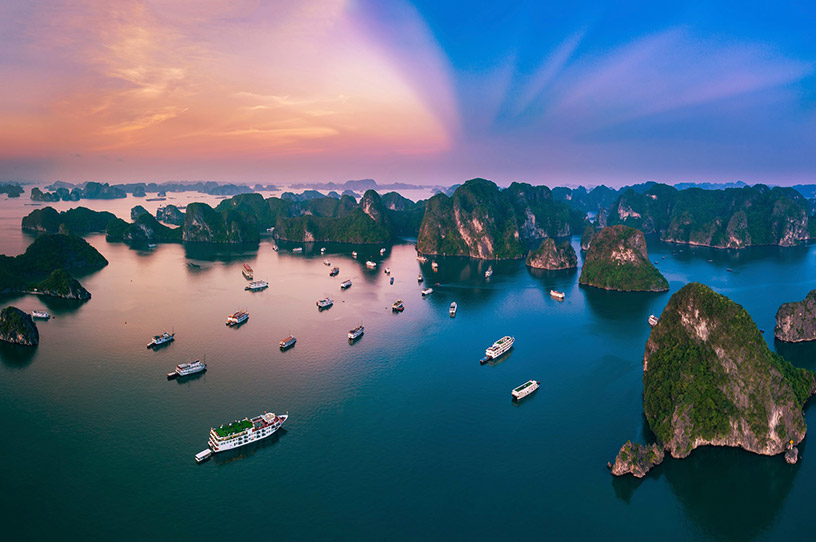
Halong Bay is often noted for its limestone mountains and natural caves formed over millions of years, scattered across 1,969 islands of various sizes. Additionally, the bay is world-famous for its rich vegetation and diverse marine life, home to over 1,000 marine species and more than 160 identified types of coral.
The UNESCO World Heritage Site covers an area of 434 square kilometers, encompassing 775 islands, of which 411 have been named. This area is renowned for its dense concentration of beautiful limestone islands, caves, and famous beaches.

Historical Milestones
Archaeological research has shown that humans have inhabited Halong Bay for over 18,000 years. Several sites belonging to the Soi Nhu culture (Middle Stone Age) and the Ha Long culture (Late Neolithic) have been discovered in the area.
In modern history, Halong Bay has witnessed several significant historical milestones of Vietnam. Notable events include the famous naval battle where King Ngo Quyen defeated the Southern Han invaders in 938 and the third victory of General Tran Hung Dao over the Mongol invaders in 1288. Today, remnants of these battles can still be found in Dau Go Cave, one of the most prominent tourist attractions in Halong Bay.
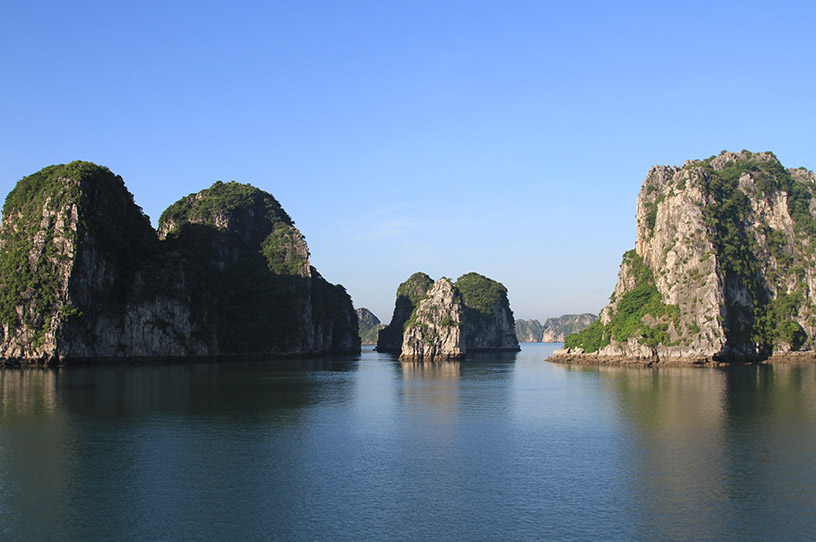
People & Culture
Ha Long City is divided into two main areas: the cultural and political center of Hon Gai and the tourism and entertainment center of Bai Chay.
In addition to these areas, there are fishing villages where a small population still lives and makes a living entirely from the sea.
Regarding religion, the majority of the local population follows Buddhism. Besides the large pagodas in Ha Long City, numerous smaller temples, shrines, and pagodas are scattered across the limestone mountains and fishing villages in the bay. Each time the fishermen set out to sea, they visit these temples, shrines, and pagodas to pray for a safe and prosperous journey.
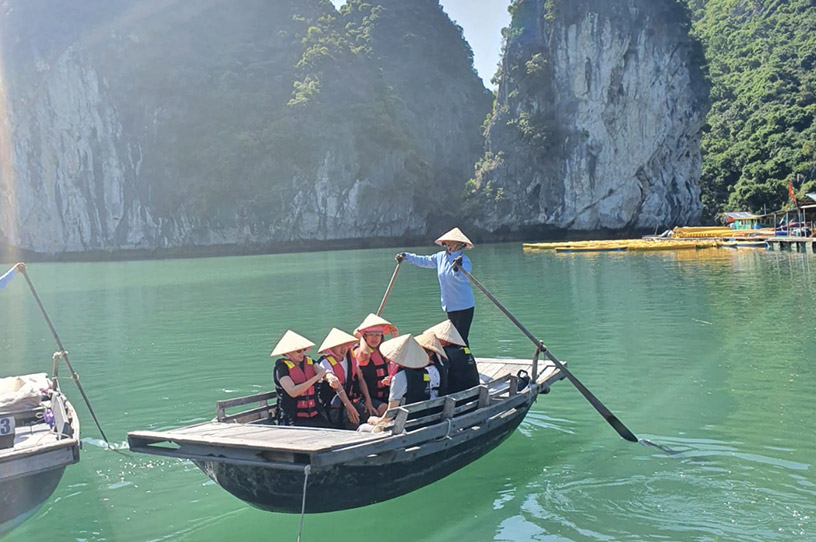
Things to Do in Halong Bay
Explore Halong Bay and Spend the Night on a Cruise
Spending the night on Halong Bay is a unique and exciting experience that most visitors choose. You’ll have the opportunity to stay on luxurious cruises, enjoying the tranquil and romantic atmosphere amidst the vast waters. You can witness breathtaking moments of sunset and sunrise over the sea, breathe in the fresh and invigorating air, paddle a kayak or ride a bamboo boat to explore the bay, and even join local fishermen in catching seafood.
Ha Long offers a range of cruise services from 2-star to 5-star standards, such as Heritage Cruises, Paradise Cruise, Stellar of the Seas, Indochine, Scarlet Pearl Cruises, Orchid, Starlight Ha Long, and Dragon Legend.
On these “floating hotels,” you can spend the night, enjoy gourmet meals, swim in pools, and take in the nighttime sea views. Some cruise tours also offer experiences like morning tai chi classes, swimming, kayaking, night squid fishing, visiting fishing villages, pearl farms, and cooking classes.
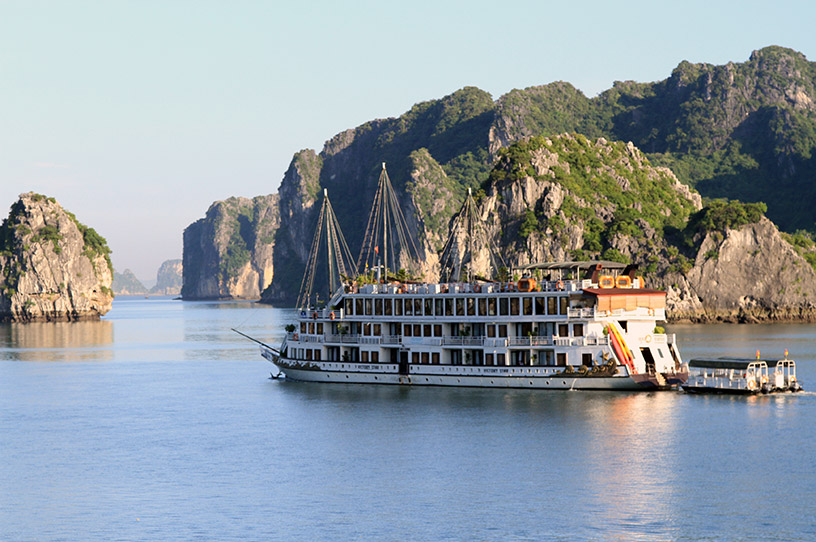
Kayaking in Halong Bay
Kayaking is another interesting and impressive activity in Halong Bay. Larger boats cannot access the bay’s hidden corners, but kayaks can. Paddling a kayak allows you to fully appreciate the majestic beauty of Halong Bay, explore the cliffs beneath thousand-year-old caves, observe birds perched precariously on rocky outcrops, and touch ancient stalactites.
If you don’t know how to swim, you might feel a bit anxious about kayaking, but it’s quite simple. It only takes about 15 minutes to get accustomed and become an experienced kayaker.
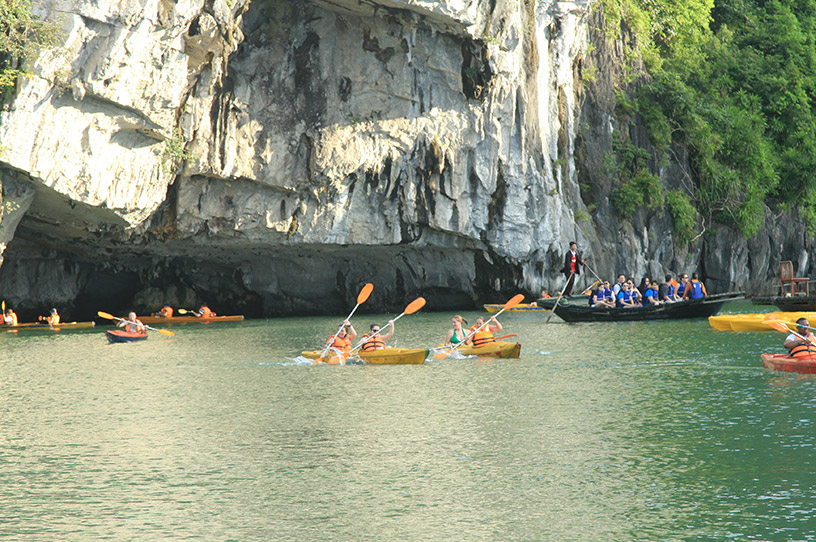
Beach Swimming
Bai Chay Beach, an artificial beach located behind Sun World Park, has been expanded nearly 1 kilometer out to sea compared to before. It features a wide expanse of clean sand, making it ideal for group games, swimming, sunbathing, or taking a stroll to watch the sunrise. Public services such as showers, changing rooms, and restrooms are available for a fee of 20,000 VND per use.
In addition to Bai Chay, Ha Long offers many other beautiful beaches for visitors to explore, such as Titop Island, Marina Bay Ha Long, Ba Trai Dao, as well as the beaches in Tuan Chau and Sun World.

Viewing Halong Bay from Above by Seaplane
To view Halong Bay, you can not only take a cruise but also enjoy aerial views by using helicopter or seaplane services. Touring by helicopter or seaplane offers a new perspective of Halong Bay’s stunning scenery. With Halong Heli Tours, you can choose a 12-minute, 25-minute, or 40-minute sightseeing tour, priced between 1.9 to 5.4 million VND per person, covering attractions such as Thien Cung Cave, Dau Go Cave, Reu Island, and Bai Tu Long. Alternatively, with Hai Au Aviation’s seaplane service, a 25-minute scenic flight costs around 1.5 million VND per person.
Tourist Attractions in Halong Bay
Hon Ga Choi Island (Fighting Cock Islet)
Hon Ga Choi, also known as Hon Trong Mai, is located in the southwest of Halong Bay, about 5 km from Bai Chay Beach. From Bai Chay Wharf, heading southwest past Stone Dog Islet and Dinh Huong Islet, you will have the opportunity to see Hon Ga Choi. This islet resembles two giant chickens (one rooster and one hen) about 10 meters high, seemingly fighting with wings spread over the vast sea.
With their precarious stance and small feet supporting the massive bodies, it seems that a strong wave could topple these rocks at any moment. However, these two rocks have stood tall between the sky and sea for hundreds of millions of years. It is this delicate balance that makes them even more fascinating. Due to their artistic and symbolic significance, Hon Ga Choi has become an iconic symbol of Halong Bay, Vietnam.
Dau Go Cave
The arch of Dau Go Cave rises about 25 meters high, with hundreds of giant stalactites hanging down like a mysterious waterfall from above. The outer chamber has a vaulted dome that attracts natural light, with layers of stalactites in various colors creating strange shapes, stimulating the imagination of visitors.
Sung Sot Cave
Located in the central area of the Halong Bay World Heritage Site, Sung Sot Cave is on Bo Hon Island. It is one of the widest and most beautiful caves in Halong Bay and is surrounded by numerous uniquely shaped islands. The path to Sung Sot Cave winds through forest canopies and up steep stone steps, requiring a short hike to reach the entrance.
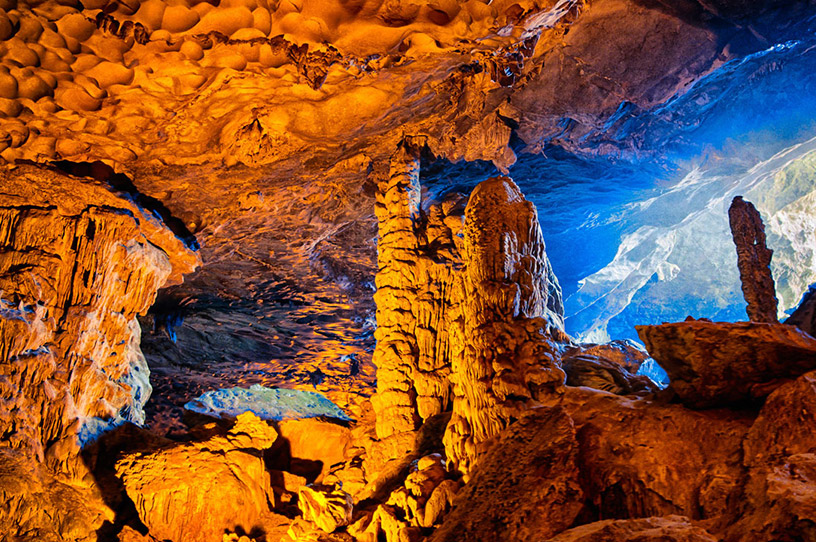
Trinh Nu Cave
Trinh Nu Cave is located on the Bo Hon archipelago, along with the Sung Sot Cave system, Ho Dong Tien Lake, and Luon Cave, about 15 km south of Bai Chay. For local fishermen, Trinh Nu Cave is their beloved home, while couples in love see it as a symbol and a place to vow their love.
Tam Cung Cave
Located in the center of Halong Bay, Tam Cung Cave is 5 km northeast of Sung Sot Cave. The cave is divided into three compartments, winding through rocky crevices. Inside, there are many beautiful stalactites. Tam Cung Cave is situated on May Den Island, which is almost isolated from other islands. The cliffs of May Den Island are steep and rugged, with lush green forests.
Me Cung Cave
Me Cung Cave is 2 km southwest of Titop Beach. The cave is located on Lom Bo Island, 25 meters above sea level. From a distance, the entrance of the cave looks like a roof deeply embedded in the side of the island. Through a narrow entrance, just wide enough for one person, the cave opens up into multiple chambers. Though narrow, the chambers are intricately decorated with stalactites resembling statues, beautiful patterns, clusters of colorful stalactites hanging from the ceiling, stone lions and bears playing together, and long stone curtains flowing down the cave walls. A faint light from afar leads to the exit. Stepping out of the cave, you can climb a few more jagged stone steps to see a round, wide lake surrounded by mountains. The lake’s water is blue and calm like a mirror, home to various species such as fish, shrimp, squid, seaweed, coral, and crabs. Next to the lake is a land area with many ancient trees, commonly known as the “royal garden,” which is breathtakingly beautiful.
Thien Cung Cave
Thien Cung Cave is located 4 km southwest of the tourist wharf on Dau Go Island, 25 meters above sea level. The path to Thien Cung Cave is steep, with lush vegetation on both sides. Through a narrow entrance, the cave suddenly opens into a space above a quadrilateral platform over 130 meters long. The deeper you go, the more amazed you will be by the vivid and splendid stalactites. The eastern wall of the cave features a magnificent mural with characters from ancient legends, with soft, intricate, and incredibly detailed lines. Both large and small sculptures are meticulously crafted by nature.
Exiting Thien Cung Cave feels like stepping out of an extraordinary art museum, where every masterpiece is created by nature, surpassing human skill and imagination.
Kim Quy Cave
Kim Quy Cave is located on Dam Nam Island, with a peak rising 187 meters. In front of it lies Dam Bac Island, and behind it is Soi Sim Island. The cave stretches 100 meters long and varies in width from 5 to 10 meters, running north to south. A small path leads up to a higher area, where water flows gently year-round, and soft, pristine stalactites hang down from the cave’s ceiling.
Bo Nau Cave
Located 2-3 km southeast of Hon Trong Mai, Bo Nau Cave is a beautiful cave shaped like a toad’s mouth, covering an area of about 200 square meters. The cave floor is wide and flat but not very deep, with many stalactites on the walls. Cracks in the ceiling allow light to filter into the cave, creating an intriguing effect for visitors. At the entrance of the cave, three rock formations resemble old men huddled together, with two playing chess and one acting as a referee. Bo Nau Cave’s unique shape, with a narrow entrance and an island in front that keeps the light soft inside, makes it one of the beautiful caves in Halong Bay worth visiting.
Luon Cave
Due to its low height of 2.5-4 meters, visitors must switch to small bamboo boats that can carry 10 to 15 people to explore Luon Cave. The journey in and out of the cave takes about 20 minutes. Although there are not many caves like this in Halong Bay, the natural scenery here is exceptionally attractive. The harmonious combination of mountains, water, sky, and vegetation creates a flawless natural beauty.
Titop Island
Located in the central area of the Halong Bay World Heritage Site, 7-8 km southeast of Bai Chay tourist wharf, Titop Island is one of the most popular destinations for visitors touring the bay. Historically known as Hong Thap Tu or Cemetery Island, it was renamed Titop Island by President Ho Chi Minh on January 22, 1962, during a visit with the Soviet astronaut Gherman Titov.
Unlike many other attractions in Halong Bay, Titop Island offers a stunning beach, Titop Beach. Visitors can climb to the top of the mountain for a panoramic view of the beautiful island. From above, the beach resembles a crescent moon embracing the island’s base. The beach’s sand is continuously cleaned by the tide, making it pristine, and the water remains clear and blue throughout the year.
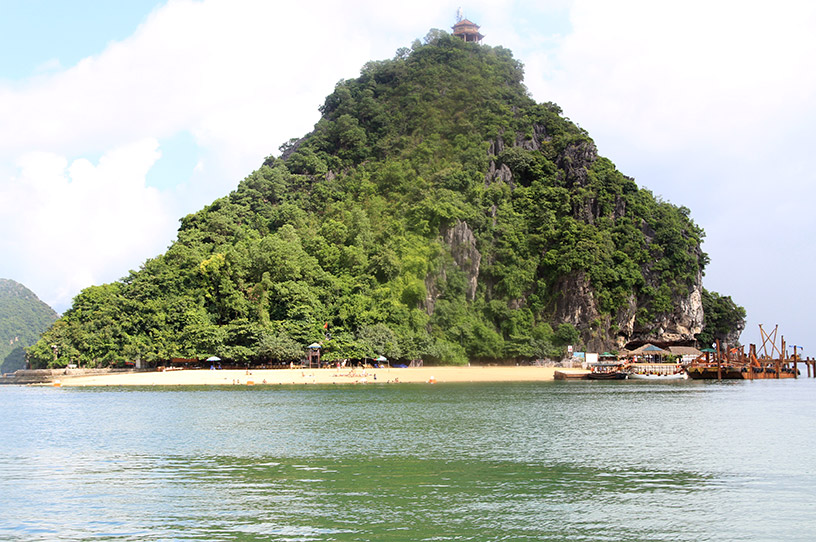
Ba Trai Dao Beach
One of the most famous beaches in Halong Bay, Ba Trai Dao Beach is located about 22 km southeast of Bai Chay tourist wharf, near Cat Ba Island. The beach boasts beautiful natural scenery, with a harmonious blend of mountains and water. It is named after three small mountains that resemble peaches from a distance. The beach’s three curved sandy stretches embrace the peach-shaped mountains, creating a picturesque scene.
This beach is tied to a romantic legend about the love between a beautiful, gentle fairy and a poor fisherman. The pristine beauty and serene environment make Ba Trai Dao Beach a must-visit destination in Halong Bay.
Tourist Fishing Villages in Halong Bay
Halong Bay and Bai Tu Long Bay are the most beautiful bays in Quang Ninh. Not only are they known for their stunning natural scenery, but they also captivate visitors with their picturesque fishing villages. For generations, the people of Quang Ninh have relied on the sea for their livelihood, creating unique fishing villages with distinctive cultural values. These fishing villages on the sea have become a highlight of Halong Bay tourism.
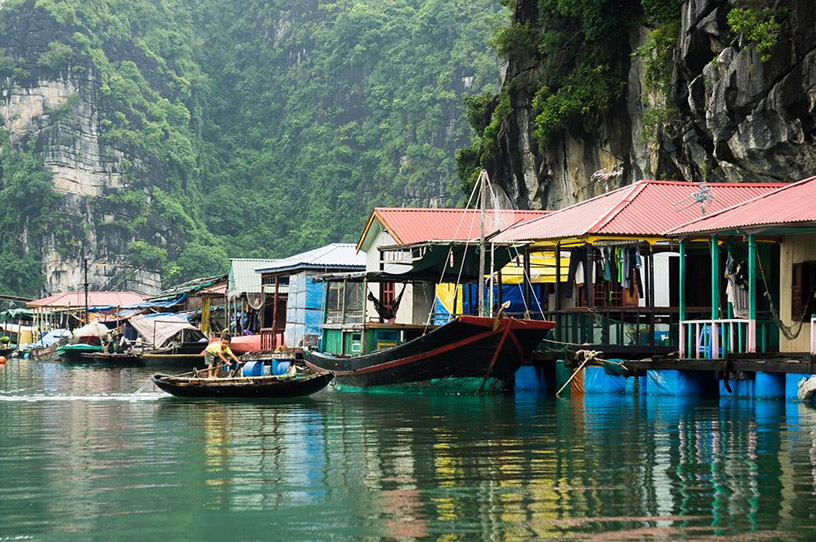
The most famous fishing villages here include Cua Van, Ba Hang, Vung Vieng, and the fishing villages in Bai Tu Long Bay. These villages appear like idyllic paintings with their characteristic simplicity. Floating on the water, these villages consist of many boat houses and fish farming cages closely linked together. The main activities of the local fishermen are fishing and aquaculture. The unique and interesting daily life of the fishermen blends with the architecture of the fishing villages, showcasing pure Vietnamese beauty and enriching the cultural value of the coastal communities. When visiting Halong Bay, you can explore the following fishing villages:
- Vung Vieng Fishing Village
- Cua Van Fishing Village
- Ba Hang Fishing Village
- Fishing Villages in Bai Tu Long Bay
- Viet Hai Fishing Village

The Best Time to Visit Halong Bay
Halong Bay experiences the distinctive climate of northern Vietnam, with four clear seasons: spring, summer, autumn, and winter. So, when is the best time to explore Halong Bay?
Each season offers different experiences. Summer, from May to July, is the peak season for domestic tourists visiting Halong Bay. During this time, temperatures can reach up to 38°C. Although it may be crowded and there is a risk of storms, you can capture many beautiful photos with blue skies and abundant sunshine.
Winter and spring, from December to April, are the peak seasons for international tourists visiting Halong Bay. During this period, the bay is less crowded, which means better services. However, the weather is often cloudy, and you may encounter foggy conditions.
Autumn, from August to November, also provides valuable experiences during the seasonal transition. The weather is favorable, offering a wonderful opportunity to admire the breathtaking natural scenery of Halong Bay.
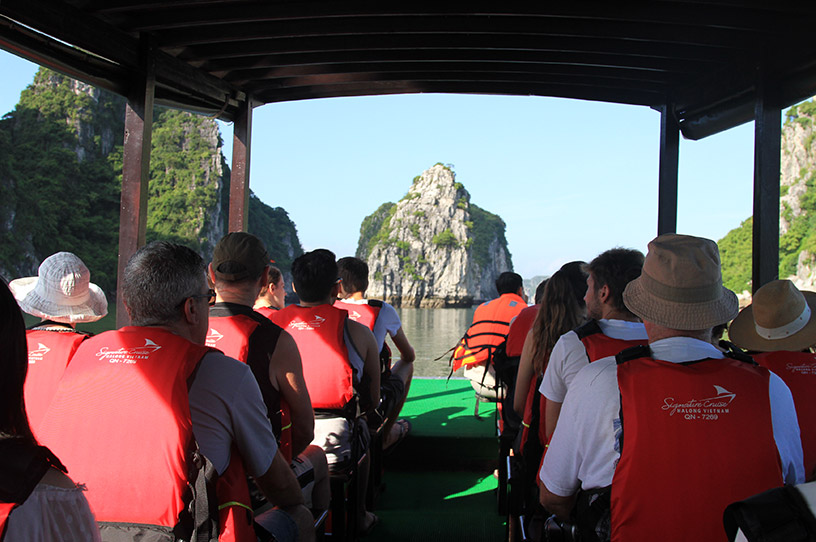
How to Get to Halong Bay
From Hanoi, you have various transportation options. Besides personal vehicles, there are limousine services that offer door-to-door pickup (such as Phuc Xuyen, Van Don Xanh, Ha Long Travel) with ticket prices ranging from 180,000 to 220,000 VND per person. Additionally, you can take a coach from bus stations within Hanoi city, with ticket prices around 150,000 to 200,000 VND per person.
Quang Ninh has Van Don Airport. Therefore, from Ho Chi Minh City and Da Nang, you can fly directly to Quang Ninh and then travel by road to Ha Long City, approximately 50 km away. There are buses from the airport to the city center.
In Ha Long, if you don’t have a personal vehicle, you can rent a motorbike for 120,000 to 200,000 VND per day. For groups such as families, friends, or colleagues, it’s advisable to hire a taxi (Mai Linh, Thanh Hung, Thinh Hung), book a Grab (bike or car), or rent a private car.
Conclusion
Halong Bay boasts a unique beauty found nowhere else on Earth. It truly deserves its status as a world wonder, and it would be a pity to visit Vietnam without exploring Halong Bay. We recommend setting aside 2 to 3 days in your itinerary to fully experience the activities at Halong Bay. We hope the information provided will help you have an unforgettable trip. If you need advice or want to book travel services, feel free to contact our dedicated sales team for assistance.

